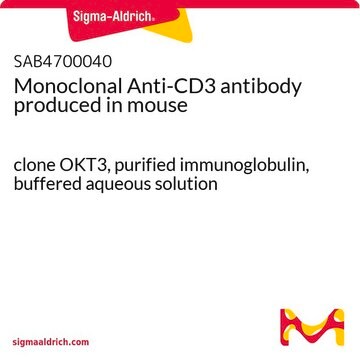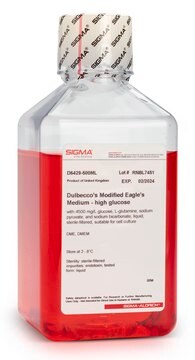SAB4700044
Monoclonal Anti-CD3 antibody produced in mouse
clone MEM-57, purified immunoglobulin, buffered aqueous solution
Se connecterpour consulter vos tarifs contractuels et ceux de votre entreprise/organisme
About This Item
Code UNSPSC :
12352203
Nomenclature NACRES :
NA.41
Produits recommandés
Source biologique
mouse
Niveau de qualité
Conjugué
unconjugated
Forme d'anticorps
purified immunoglobulin
Type de produit anticorps
primary antibodies
Clone
MEM-57, monoclonal
Forme
buffered aqueous solution
Espèces réactives
human
Concentration
1 mg/mL
Technique(s)
flow cytometry: suitable
Isotype
IgG2a
Numéro d'accès NCBI
Conditions d'expédition
wet ice
Température de stockage
2-8°C
Modification post-traductionnelle de la cible
unmodified
Informations sur le gène
human ... CD3(916)
Catégories apparentées
Description générale
The antibody MEM-57 reacts with gamma-epsilon and delta-epsilon dimers of human CD3 complex, a part of a bigger multisubunit T cell receptor complex (CD3/TCR) expressed on peripheral blood T lymphocytes and mature thymocytes.
Immunogène
Human thymocytes and T lymphocytes
Application
The reagent is designed for Flow Cytometry analysis. Suggested working dilution is 2-5 μg/mL of sample. Indicated dilution is recommended starting point for use of this product. Working concentrations should be determined by the investigator.
Caractéristiques et avantages
Evaluate our antibodies with complete peace of mind. If the antibody does not perform in your application, we will issue a full credit or replacement antibody. Learn more.
Forme physique
Solution in phosphate buffered saline, pH 7.4, with 15 mM sodium azide.
Clause de non-responsabilité
Unless otherwise stated in our catalog or other company documentation accompanying the product(s), our products are intended for research use only and are not to be used for any other purpose, which includes but is not limited to, unauthorized commercial uses, in vitro diagnostic uses, ex vivo or in vivo therapeutic uses or any type of consumption or application to humans or animals.
Vous ne trouvez pas le bon produit ?
Essayez notre Outil de sélection de produits.
Code de la classe de stockage
10 - Combustible liquids
Point d'éclair (°F)
Not applicable
Point d'éclair (°C)
Not applicable
Faites votre choix parmi les versions les plus récentes :
Déjà en possession de ce produit ?
Retrouvez la documentation relative aux produits que vous avez récemment achetés dans la Bibliothèque de documents.
Luciën E P M van der Vlugt et al.
The Journal of infectious diseases, 210(8), 1207-1216 (2014-05-06)
Chronic schistosome infections are associated with T-cell hyporesponsiveness and a strong regulatory network. Murine studies have shown that schistosome infections can induce regulatory CD1d(hi) B cells, which inhibit inflammatory responses. Here, we evaluated the influence of regulatory B cells (Bregs)
Rinat Sharir et al.
Cardiovascular research, 103(4), 585-596 (2014-06-27)
Ischaemic damage is associated with up-regulation of pro-inflammatory cytokines, as well as invasion of leucocytes and lymphocytes to the injured muscle. Regulatory T cells (Tregs) exert suppressive effects on several immune and non-immune cellular elements. We hypothesized that adoptive Treg
Isabel Poschke et al.
Cancer immunology, immunotherapy : CII, 63(10), 1061-1071 (2014-07-06)
Adoptive transfer of in vitro-expanded tumor-infiltrating lymphocytes (TIL) has shown great clinical benefit in patients with malignant melanoma. TIL therapy itself has little side effects, but conditioning chemo- or radiotherapy and postinfusion interleukin 2 (IL-2) injections are associated with severe
Simon C Afford et al.
Hepatology (Baltimore, Md.), 59(5), 1932-1943 (2013-12-18)
Chronic hepatitis occurs when effector lymphocytes are recruited to the liver from blood and retained in tissue to interact with target cells, such as hepatocytes or bile ducts (BDs). Vascular cell adhesion molecule 1 (VCAM-1; CD106), a member of the
Jong Joo Lee et al.
Purinergic signalling, 10(2), 357-365 (2013-09-18)
This study investigated the immune-modulatory effects of human bone marrow-derived mesenchymal stem cells (hBMSCs) on human Th17 cell function through the CD39-mediated adenosine-producing pathway. The suppressive effects of hBMSCs were evaluated by assessing their effects on the proliferation of Th17
Notre équipe de scientifiques dispose d'une expérience dans tous les secteurs de la recherche, notamment en sciences de la vie, science des matériaux, synthèse chimique, chromatographie, analyse et dans de nombreux autres domaines..
Contacter notre Service technique





